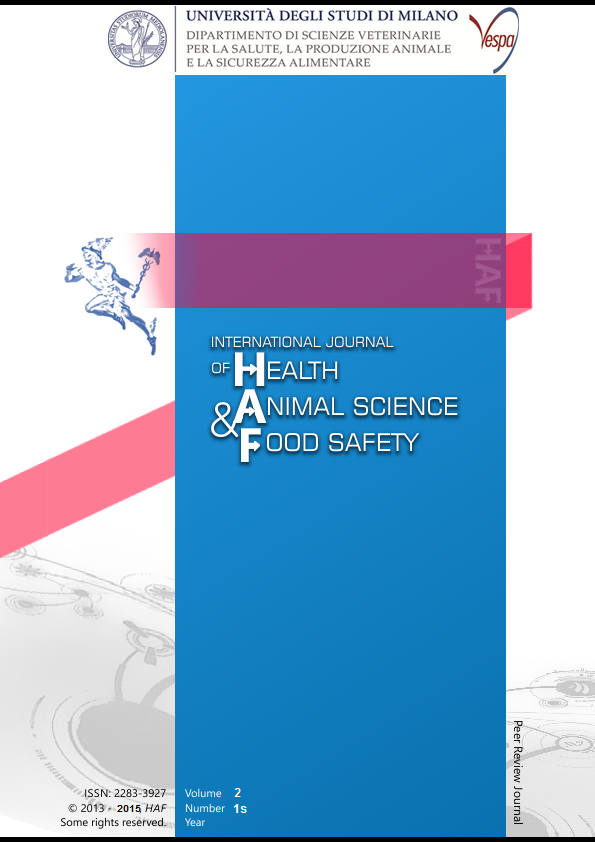Abstract
Italian Tortoises species are considered either endangered or near threatened according to International Union for Conservation of Nature. When pet tortoises are abandoned or found injured or seized following illegal detention, they are sent to wildlife rehabilitation centers. From 2008, the Testudo spp. population housed in the WWF Vanzago’s oasis exhibited clinical signs compatible with Testudinid herpesviurs 3 (TeHV3) infection. By the end of 2012 all Testudo had died. The presence of TeHV3 was investigated by molecular biology and pathology. All the tortoises housed in Vanzago resulted ELISA positive for the presence of anti-TeHV3 antibodies except one T. hermanni. Of these, 12 animals died and were all necropsied. Lesion frequency distribution was evaluate by histology. PCR was positive in 8/12 tortoises. To better complement the epidemiological evaluation of the virus in northern Italy, 20 retrospective cases were selected from the archive of the University of Milan. Of these, 5 were TeHV3 PCR positive. Lesions closely resembled those of the Vanzago’s population. These results are consistent with a high prevalence of TeHV3 in northern Italy. The finding of intranuclear inclusion bodies demonstrated to be specific but not sensitive. TeHV3 diagnostic pathological lesions have been reported to vary according with host immune response and by the viral replicative status. Molecular techniques were often necessary to confirm the infection. According to the literature and to our findings, T. hermanni spp. seems the species with higher mortality and lower antibody concentrations when infected with TeHV3.Italian Tortoises species are considered either endangered or near threatened according to International Union for Conservation of Nature. When pet tortoises are abandoned or found injured or seized following illegal detention, they are sent to wildlife rehabilitation centers. From 2008, the Testudo spp. population housed in the WWF Vanzago’s oasis exhibited clinical signs compatible with Testudinid herpesviurs 3 (TeHV3) infection. By the end of 2012 all Testudo had died. The presence of TeHV3 was investigated by molecular biology and pathology. All the tortoises housed in Vanzago resulted ELISA positive for the presence of anti-TeHV3 antibodies except one T. hermanni. Of these, 12 animals died and were all necropsied. Lesion frequency distribution was evaluate by histology. PCR was positive in 8/12 tortoises. To better complement the epidemiological evaluation of the virus in northern Italy, 20 retrospective cases were selected from the archive of the University of Milan. Of these, 5 were TeHV3 PCR positive. Lesions closely resembled those of the Vanzago’s population. These results are consistent with a high prevalence of TeHV3 in northern Italy. The finding of intranuclear inclusion bodies demonstrated to be specific but not sensitive. TeHV3 diagnostic pathological lesions have been reported to vary according with host immune response and by the viral replicative status. Molecular techniques were often necessary to confirm the infection. According to the literature and to our findings, T. hermanni spp. seems the species with higher mortality and lower antibody concentrations when infected with TeHV3.Riferimenti bibliografici
F. C. Origgi. 2012. Journal of Herpetological Medicine and Surgery 22 ( 1-2): 52-54; E. R. Jacobson., K. H. Berry, F. C. Origgi , J. F. Jr Wellehan, A. L. Childress, J. Braun, M. Schrenzel, J. Ye, B. Rideout. 2012. Journal of Wildlife Diseases 48(3): 747-57; F. C. Origgi, C. H. Romero, D. C. Bloom, P. A. Kelin, J. M. Gaskin, S. J. Tucker, E. R. Jacobson. 2004. Veterinary Pathology 41(1): 50-61; J. F. Soares,V. J. Chalker, K. Erles, S. Holrby, M. Waters, S. McArthur. 2004. Journal of Zoo and Wildlife Medicine 35(1): 25-33; A. J. Johnson, A. P. Pessier, J. F. Wellehan, R. Brown, E. R. Jacobson. 2005. Veterinary Microbiology 111(1-2): 107-16.
This work is licensed under a CC BY-SA 4.0 international

